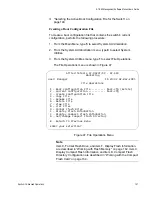
Chapter 7: LACP Port Trunks
134
Section I: Basic Operations
Deleting an Aggregator
This procedure deletes an aggregator from the switch. The ports that are
members of the aggregator stop transmitting LACPDU packets after the
aggregator is deleted.
Caution
Disconnect the cables from the ports of the aggregator before
performing the following procedure. Deleting an aggregator without
first disconnecting the cables can create loops in your network
topology. Data loops can result in broadcast storms and poor
network performance.
To delete an aggregator, perform the following procedure:
1. From the Main Menu, type
1
to select Port Configuration.
2. From the Port Configuration menu, type
4
to select Port Trunking and
LACP.
The Port Trunking and LACP menu is shown in Figure 35 on page 116.
3. Type
2
to select LACP Configuration.
The LACP (IEEE 8023ad) Configuration menu is shown in Figure 39
on page 126.
4. Type
5
to select Delete Aggregator.
The following prompt is displayed:
Enter Aggregator Name [Max up to 20 alphanumeric
characters]:
5. Enter the name of the aggregator you want to delete. The name is
case-sensitive. You can delete only one aggregator at a time.
The following prompt is displayed:
Are you sure you want to delete this aggregator (Y/N) [Yes/No]
->
6. Type
Y
to delete the aggregator or
N
to cancel the procedure.
If you entered Yes, the aggregator is deleted.
7. To permanently save your change, return to the Main Menu and type
S
to select Save Configuration Changes.
Summary of Contents for AT-9400
Page 16: ...Figures 16 ...
Page 18: ...Tables 18 ...
Page 28: ...Preface 28 ...
Page 30: ...30 Section I Basic Operations ...
Page 60: ...Chapter 1 Basic Switch Parameters 60 Section I Basic Operations ...
Page 64: ...Chapter 2 Port Parameters 64 Section I Basic Operations Port Type The port type ...
Page 84: ...Chapter 2 Port Parameters 84 Section I Basic Operations ...
Page 124: ...Chapter 6 Static Port Trunks 124 Section I Basic Operations ...
Page 144: ...144 Section II Advanced Operations ...
Page 196: ...Chapter 10 File Downloads and Uploads 196 Section II Advanced Operations ...
Page 218: ...Chapter 11 Event Logs and the Syslog Client 218 Section II Advanced Operations ...
Page 242: ...Chapter 13 Access Control Lists 242 Section II Advanced Operations ...
Page 294: ...294 Section III IGMP Snooping MLD Snooping and RRP Snooping ...
Page 314: ...Chapter 19 MLD Snooping 314 Section III IGMP Snooping MLD Snooping and RRP Snooping ...
Page 318: ...318 Section IV SNMPv3 ...
Page 416: ...Chapter 21 SNMPv3 416 Section IV SNMPv3 ...
Page 418: ...418 Section V Spanning Tree Protocols ...
Page 470: ...470 Section VI Virtual LANs ...
Page 520: ...Chapter 26 Multiple VLAN Modes 520 Section VI Virtual LANs ...
Page 532: ...Chapter 27 Protected Ports VLANs 532 Section VI Virtual LANs ...
Page 546: ...546 Section VII Internet Protocol Routing ...
Page 560: ...560 Section VIII Port Security ...
Page 568: ...Chapter 30 MAC Address based Port Security 568 Section VIII Port Security ...
Page 586: ...Chapter 31 802 1x Port based Network Access Control 586 Section VIII Port Security ...
Page 588: ...588 Section IX Management Security ...
Page 610: ...Chapter 33 Encryption Keys 610 Section IX Management Security ...
Page 650: ...Chapter 36 TACACS and RADIUS Protocols 650 Section IX Management Security ...
Page 660: ...Chapter 37 Management Access Control List 660 Section IX Management Security ...
Page 668: ...Index 668 ...
















































